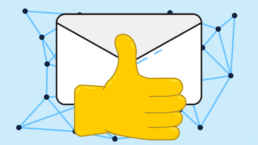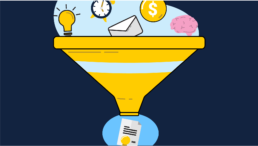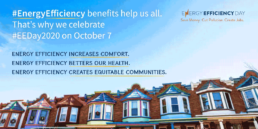5 Ways To Improve Your Digital Marketing Game in 2022
It’s 2022. We live in a digital age. And when every business uses digital channels for marketing — how do you stand out from your competition? How do you catch the eye of your ideal clients or customers in the crowded online space? How do you create authentic messaging that will resonate in all the right ways, translating into super fans and, ultimately, increased revenue?
Start with strategy. By creating purposeful content, you’re five steps ahead of most of your competitors. Here’s how to do it.
A two-pronged approach: build relationships & boost sales
There are so many people doing great work in the world, solving problems & offering creative solutions. There are a few things you can do to help your business stand out from the crowd & help to move your marketing from good to great: use a two-pronged approach to 1) build relationships and 2) boost sales.
Relationships, baby
Nobody loves buying from a business whose only goal is to sell, sell, sell. When you start by building authentic, long-term, loyal relationships with your current and potential customers or clients, you set the tone for future sales. Make them fall in love with your brand, your ethos, and the way you do business. Because we all know that making a single sale feels good — but establishing an ongoing relationship that results in multiple sales is great.
Sell the life transformation (not your product or service)
You can’t focus solely on relationships — you’ve got to sell your services or products, too. Think about problem-solving ahead of dollar signs when it comes to selling. People want to buy a solution. A life transformation. They care about themselves (a lot more than they care about making money for your company). It’s all about positioning. And when you crack the code of how to position your offer, that’s when the magic happens.
5 ways to “up” your digital marketing game
If your digital marketing game isn’t up to par, a complete overhaul can feel daunting. It’s okay to start with baby steps — upgrading one thing at a time — to move toward your goals. By trying one thing at a time, you can test what works best for you and your company — and you’ll have a concrete measurement of success.
Here are 5 things you can do to escalate your digital marketing success.
1. Develop a monthly/quarterly content strategy
Map out buckets of content topics by month or quarter that you’d like to focus on. Organize and build your content strategy into a spreadsheet — and stick to it! Make sure you shoot for a doable volume of work and that you can divide the content into various mediums (more on that later) that can be executed by a pro in that area. Decide who will do what, when, and stay on track. Because having a strategy that you never use is, well, worthless.
2. Create the ultimate buyer’s journey
Many business owners and executives have a blind spot when it comes to their own customers’ journey. When you’re really close to something (i.e. your services, products, or offers), it can be hard to put yourself in a brand new customer’s shoes and decide if the flow of their journey makes sense. Pretend you know nothing about your brand/business. What would a cold lead want to know? How do you explain your offer? Make sure to be clear over clever or cute. Counter their objections. Provide social proof. Make them fall in love with the life transformation you’re selling — from beginning to end of their experience getting to know you/your brand/business.
3. Vary your content medium (social media, blogs, videos, podcasts, etc.)
The human brain gets bored really quickly. They say that we have the attention span of a goldfish — 5 seconds. We like change, variety, and surprises. Make sure you publish content for your digital audience in multiple mediums to keep your audience on their toes and engaged in your content.
4. Focus on customer service
Don’t forget that there’s a human on the other side of every screen. If you rely on automations or AI to service your customers — news flash – they’re going to notice. And chances are…they aren’t going to love it. Be human. Admit mistakes. Be transparent. Offer to fix issues/problems. Just be nice. It’s highly underrated.
5. Assess, tweak, update, and refine your content monthly/quarterly
After you put your digital marketing to work — make sure you don’t “set it and forget about it.” Ads, websites, blogs, emails, videos, podcasts all need to be tweaked, updated, and refined from time to time. Make sure you’re staying relevant — and conscious of current events and how your marketing might land on certain groups during certain times. Make a plan to review and optimize existing content plans at least bi-annually, if not quarterly. It’s surprising how quickly things can become outdated or appear (even if unintentionally) offensive.
Digital marketing is here to stay. And if you’re looking for ways to improve your digital marketing — you’re already ahead of the game! Remember to start with strategy and build from there. Keep your audience at the forefront of your positioning & language. Whenever possible, put yourself in their shoes and see if your offers resonate with someone unfamiliar with what you do.
Lindsay Hope is a copywriter and marketing strategist with CoPeace. As a forward-thinking holding company, CoPeace is building a portfolio of carefully selected for-profit companies with measurable social and environmental impact. To learn more about impact investing, check out CoPeace’s Intro to Impact Investing.
Cows, Colleges, and Contentment… and Capitalism

I have always been intrigued by the concept and study of contentment and happiness. Northfield, Minnesota’s slogan of “Cows, Colleges and Contentment” lured me in when I was looking at undergraduate schools – it was a sunny day at Carleton College when I visited in the summer of 1982. I am pretty sure that under my college yearbook picture (book was recycled in our last “lighten the load” purge before we recently moved, so I can’t verify), my stated future goal in life was “contentment.” In our divisive times, it feels like we all might benefit from added scientific wisdom on the topic…
A recent article, “Things That Will Make You Happier Than Winning the Lottery,” piqued my interest. In it, Harvard Professor Sanjiv Chopra explores the research and findings. It turns out that money truly does not buy happiness – people who win the lottery lose the excitement soon after: “The research shows that at the end of a year, they’re back to baseline. Some are less happy,” Chopra says.
Chopra also shares Three Keys to being happier people: Purpose (Dharma), Giving, and Gratitude. The findings resonate with me and feel consistent with the hopeful themes of the season!
It is interesting, then, how important having access to the right amount of capital enables Chopra’s three keys. It is difficult to serve your purpose, give, or express appropriate gratitude if you don’t have the funds to do the work.
ESG-driven impact investors attempt to strike a similar balance. Creating inclusive, socially impactful wealth for all people is not possible without the wherewithal to take meaningful steps forward.
The good news is that the purpose-based recipe is working for a new brand of responsible capitalism. The need for evolved ESG-driven models continues to grow, supporting companies actively doing the important work of our time: purposefully helping solve the climate emergency, giving alternative buckets of capital that support entrepreneurs in disadvantaged communities, and expressing gratitude through paying fair and equitable wages.
At Carleton, I was privileged to get to know Paul Wellstone in a unique way. Before he served as the Senator from Minnesota, he taught Political Science at Carleton. He was a huge sports fan and former college athlete. We would share a beer (or 2) at Sayles Hill after basketball games – it was a different time and our interpretation post-game carbo loading seemed encouraged… He would always have some interesting perspectives on our strategy and approach. He usually thought we could pressure the ball more on defense and rebound with more effort (he was right – you can always play harder).
As Senator, Wellstone became famous as a voice for communities that had not been well served by the status quo. He was known for the maxim, “We all do better when we all do better.” He believed capitalism had a deep responsibility to be more inclusive while promoting innovation and allowing all entrepreneurs the opportunity to thrive in its competitive marketplace.
The late Senator would approve of the ESG-driven impact investing movement. Howard Buffett, Warren’s grandson, recently tweeted about how the ESG-driven movement needs to be intentional about its growth, and strive for more uniform measurements that all can understand.
Young people are driving the change. Students are demanding change. One of the interesting things about the juxtaposition of colleges and capitalism is that the wealth gap we see in individuals is exaggerated in the university setting between the wealthy and less advantaged schools. For the more elite schools, college endowments have grown with strong returns. The less advantaged schools are in danger of shutting down. Students are seeking transparency and demanding more alignment with the Environmental, Social and Governmental goals of the ESG movement. Chopra’s own school has bowed under student pressure and has announced they will be changing the way they measure returns in a more inclusive way – the good news for Harvard is that ESG-driven business is growing and showing excellent returns.
For me, as I have matured, I know a more inclusive capitalism will lead to a better, more contented world. We need all the help we can get on that front. And, from one of the learnings from our sports world experience, we can’t let perfect be the enemy of the good as we take direct action. Significant capital and innovative models are leading the change, and it is OK to take one step at a time.
I am grateful that we still have some time, however limited, to give our duty some hope.
Craig Jonas is the CEO and founder of CoPeace. As a forward-thinking holding company, CoPeace is building a portfolio of carefully selected for-profit companies with measurable social and environmental impact. To learn more about impact investing, check out CoPeace’s Intro to Impact Investing.
The Anatomy of a Highly Connective, High-Converting Email
Share
The Anatomy of a Highly Connective, High-Converting Email
Part of a series on effective digital communication
By Lindsay Hope
As the year 2021 comes to a close, there’s a lot of marketing lessons to glean from the extended pandemic world we’re living in. For those of us in the small business digital space, one of the top takeaways is: Never underestimate the power of email. (Contrary to what you might have heard, email is not dead.)
With an ROI of 3,800-4,400% (according to Hubspot), it’s undeniable that email is the channel to utilize and optimize as we turn the corner into next year. Emails solve problems and build connections with your audience. Then, when it comes time to sell your products or services, you’ve already established trust, built authority, and primed your prospects to buy.
Think about that ROI stat in a different way: for every $1 spent, email generates an average of $38-44. When you think about the cost of developing an email marketing strategy vs. attempting to acquire customers via social media platforms (which can cost up to five times as much!), you’ll find that there’s no comparison in terms of value.
So, once you’re convinced that email marketing is the way to go, next, you’ve got to learn how to create highly connective, high-converting emails.
What separates a decent email from a super fantastic email that your prospects can’t wait to open, read, and engage with? A few things.
1. An Enticing Subject Line
The NUMBER ONE goal of your subject line is to get the reader to open your email. Create curiosity, urgency, and intrigue — but don’t be clickbaity! Make sure you’re authentic and deliver what you say you will. Subject line length can vary, but as a good rule of thumb, shorter is better (try under nine words and around 60 characters maximum). But remember — there’s no right or wrong way to write a subject line. Your audience might prefer a different format or style than other audiences.
Pro tip: Test, test, test! Use trial and error to find out what works best to get engagement with your audience and for your brand. Try using emojis, title and/or sentence case, and longer vs. shorter subject lines. Most email service programs provide an option to A/B test two different subject lines. This means you can send two options to a portion of your audience (usually around 20%) to determine which one works better/gets more opens. Then the winning subject line is sent to the remainder of your list. Take advantage of this! Test, optimize, and test again.
2. Optimized Preview Text
Never ignore this valuable email real estate! Consider what people will see when they read emails on their phones. This almost always includes at least one line of a preview text. Optimize your email copy for the small space you have after the subject line to sweeten the deal — aka incentive to open — your email.
Pro tip: The first few words of your preview text count the most! Make sure your reader will see the most important information first. Give them the critical information that the email is about — and still, find a way to lure them into clicking it open and reading the rest.
3. Focused Body Copy
Once you’ve earned the open, make sure you provide concise, valuable information in the body of your email! Start with a great hook to keep the reader interested. Get quickly to the point of your email; you don’t want to lose their attention (which isn’t going to last more than a few seconds, trust me). Don’t write a novel here… emails are meant to be concise. Make sure every sentence delivers value. If it doesn’t, delete it.
Pro tip: Focus each email on only one idea. Multiple ideas dilute your message and can confuse your reader, making it less likely that they’ll take the action you want them to take. This leads to the next point…
4. A Killer CTA
Don’t be shy — tell your readers what you want them to do while/after reading your email. Write a call to action (CTA) that they can’t help themselves from clicking. It can be as simple as “Buy Now” or “Book a Call,” or you can try getting creative with it. Within the email is not the time to beat around the bush. Make sure you give the reader a reason to have opened your email!
Pro tip: Use the same CTA throughout the email to give your reader multiple opportunities to take the action you want them to take. You can even add it again in the P.S.
5. BONUS: A Few Additional Important Tips
– Personalization in emails is uber-important. Go beyond adding a greeting with someone’s first name. Segment your audience according to the parameters you deem important — actions they’ve taken, demographic characteristics, or triggers that are relevant to your business. Personalization helps you deliver critical information to the right audience at the right time.
– Optimize your offer. If the copy you’re using in your emails isn’t working, go back to the drawing board and think of another way to build a relationship with them and give them what they want. Think beyond features and dig into benefits. How will your product or service transform their life? For example, the end goal of an alarm clock probably isn’t just to wake up earlier. It’s a trigger that helps them get up early to work out, meditate, or read a business book to help them achieve a result.
– Pay attention to timing and frequency. For many businesses, Tuesdays are the best day to send weekly emails. Is that true for your business? Maybe so, maybe not. Test this too so you can optimize the time and frequency when you connect with your audience.
One of the biggest mistakes you can make with email marketing is waiting to get started.
You don’t need to have an intricate strategy to start communicating with your prospects and customers via this channel. Sure, it’s helpful to build that over time, but don’t let the lack of a robust strategy hold you back from simply saying, “Hello, here’s what we’re all about, do you want to learn more?” to them. Your only regret will be not starting to communicate with email sooner.
Lindsay Hope is a copywriter and marketing strategist with CoPeace. As a forward-thinking holding company, CoPeace is building a portfolio of carefully selected for-profit companies with measurable social and environmental impact. To learn more about impact investing, check out CoPeace’s Intro to Impact Investing.
Marketing Funnels 101
No matter what your business sells or provides or what role you have in your company, one of the essential areas of knowledge you can gain to ensure your business’ success is understanding your customer’s journey. It’s always a good investment to spend time studying how leads find you and what turns them into loyal fans and paying customers. Understanding the customer’s journey helps you develop marketing that resonates with them, builds connections, and gets you the end result you seek. It’s how you create marketing that works.
If you don’t come from a marketing background, the idea of a marketing funnel may not be one of your core competencies. However, once you get familiar with how a funnel works — and what to consider to make it work — you’ll elevate your ability to make decisions not based on what you want and need but what your customers want and need. See the difference?
The Stages of Awareness
All businesses are created to solve problems. When you put on your “marketing” hat, it’s important to understand that depending on the stage of your customer’s awareness about their pain or problem, possible solutions, and YOUR solutions, you’ll present your offer (or solution) using different techniques, and with different messaging.
There are five stages of awareness that your prospects might fall into.
Unaware. When prospects don’t even realize they have pain or a problem, they’re considered unaware. FYI – this is the most challenging group of folks to market to.
Pain Aware. If a prospect has identified that they’re having a pain or a problem but haven’t started thinking about solutions to remedy that pain, they’re considered pain aware.
Solution Aware. Prospects that have felt pain and also discovered that solutions exist for it are solution aware.
Product Aware. If prospects know that your product is one of the solutions to their pain or problem, they’re product aware.
Most Aware. When prospects know that your solution is not just one of the solutions, but the best solution to solving their pain or problem, they’re most aware.
If you think about these stages of awareness like a funnel, generally, people who are unaware and pain aware are considered to be near the top of the funnel, where people who are most aware are at the bottom of the funnel.
The Top, Middle, and Bottom of The Funnel
Depending on where you’re finding your leads and their stage of awareness, you’ll want to introduce them to your brand at different stages in the marketing funnel. Each stage of the funnel exists for a different purpose — with the ultimate goal of converting leads into long-time fans and paying customers of your business.
Top of the funnel. When creating materials for the top of the funnel (unaware or pain aware prospects, typically), you’re establishing credibility and starting to build trust. Top of the funnel marketing pieces include blog posts, infographics, events, webinars, direct mail, and social media posts. Content for these pieces is informative, grabs your audience’s attention, and teaches them something — piquing their interest and luring them in to learn more about you, your company, and your product or service as they move into the next stage of the funnel.
Middle of the funnel. The middle of the marketing funnel engages your audience and introduces them to your product or service and perhaps more importantly — your positioning. Nurture them in this stage by providing valuable information and targeted content. What sets you apart from your competition? How does your product or service differ and outperform that of your competitors? Content for the middle of the funnel includes emails, targeted newsletters, classes, case studies, free trials, and more.
Bottom of the funnel. Once prospects have moved through the stages of awareness and understand that your business can solve their problems better than anyone else’s, it’s time to help them make their final purchasing decision and convert them to paying customers. They’ve already evaluated the competition, so to move them to purchase, demonstrate social proof (reviews, testimonials) and the benefits — over the features — of choosing you over your competition. Your offer at this stage can make or break your conversion rates, so be sure you’ve thought about the best way to present your solution and wrap it up and tie it with an irresistible bow.
The Bottom Line = Research Matters
Throwing things against the wall to see what sticks is not a strategic marketing strategy. To build a marketing funnel that works, understanding your customers, what motivates them, and creating language that resonates with them as a solution to their problems is invaluable. Before creating a marketing funnel, be sure to study what matters most to your prospects. That way, creating effective materials that are in line with their stage of awareness will move them through your marketing funnel with greater success = higher conversions.
Lindsay Hope is a copywriter and marketing strategist with CoPeace. As a forward-thinking holding company, CoPeace is building a portfolio of carefully selected for-profit companies with measurable social and environmental impact. To learn more about impact investing, check out CoPeace’s Intro to Impact Investing.
It's All in My Head!

One of the brightest and most talented people I ever worked with was so smart and quick-minded that she could tell you anything and everything about her business off the top of her head at a high level. I will call her Elise (not her real name) so as not to disclose her identity. Elise could drill down into the details in response to the most challenging of questions, generate excitement, and garner true interest from prospective investors, clients, bankers, and other stakeholders. The business case was strong and Elise as an entrepreneur had all the right stuff. Then, when asked to follow up with a pitch deck or a plan, she became paralyzed. Yes, there was tremendous knowledge and experience, and incredible ideas inside Elise’s head, but when asked to put it into a tangible presentation on digital paper (saving trees here!), the momentum stalled.
When investing in a young and growing business, entrepreneurial leadership team is the most important piece of the puzzle. Company founders are visionaries. They boot strap their businesses and put it all on the line. When it comes time to bring in outside funds, family, friends, and trusted advisors validate the founder’s vision with financial support, advice, and make introductions to potential investors, clients, vendors, and other stakeholders. Much of this can be accomplished on the strength of the entrepreneur’s vision, passion, and personal relationships. Then, there comes a point when outside help is needed to fuel the growth of the enterprise.
Re-enter Elise. You can’t help but get excited when you hear Elise talk about her business, the vision, and the pathway to an impactful and important place in her industry. The challenge was, how do you take that excitement and translate that into something that potential stakeholders will understand, appreciate, and buy in to? After empathizing with Elise’s angst, she said to me, “it’s all in my head…I just can’t get it out onto [digital] paper!”
An entrepreneur wears many hats and must take on certain tasks and responsibilities outside her core competencies. Elise knew how to get things done, but she was stuck. The thing is, while that was hard for Elise to admit and address, she knew she needed help. Thankfully, I had a lot of experience in this area and was able to take enough “dictation” from Elise, where she could just relax and tell me about her business in detail, and I was able to construct a pitch deck and projections, which she was able to use to tell her story to prospective stakeholders. Numbers, graphs, flow charts, infographics galore came out of Elise’s stream of consciousness, and she delegated that seemingly insurmountable task to a trusted friend in me to take her vision and translate it into a cohesive set of presentation materials that illustrated her story. The end of the movie is that Elise went on to raise substantial amounts of capital and built a very successful business with a leadership team that has the necessary skill sets to continue to scale the enterprise profitably.
Why does a business need projections and pitch materials? There are many important reasons:
- In the early stages of a business, investors bet on the founder and the leadership team. The performance of that team will hopefully translate into positive and impactful results. While one can appreciate and acknowledge a skilled leadership team, the business must translate that vision into numbers and projected future returns to attract investors, particularly when raising capital outside of family and friends.
- The process of creating projections has tremendous value to the founder and the leadership team, and it compels them to look at the business critically to understand their costs, scalability, strengths, weaknesses, opportunities, and threats. It’s a healthy exercise to prepare and update projections periodically as the business model evolves and proves out in practice. Business and economic conditions always change. It’s healthy to incorporate this as a periodic team review of what worked, what didn’t work, and where things are headed.
- As a business evolves, projections are also helpful in attracting new investors, vendors, industry partners, clients, banking relationships, and governmental interest on many levels.
- A solid set of projections with clearly articulated assumptions, an engaging pitch deck, and cohesive and consistent company messaging are essential to building the credibility and brand equity for an enterprise.
When I was in graduate school I remember being encouraged to “show not tell” in my writing. In the case of a growing enterprise, I believe it’s important to do both SHOW and TELL. Nobody tells the story better than the company founder, like Elise! But you can do Show and Tell on a whole other level with a well thought out set of projections, pitch deck and other materials that help articulate the story.
The moral of the story is:
- It doesn’t need to be all in your head, let it out!
- Ask for help from trusted sources and take a load off.
- This can turn out to be a case where 1 + 1 is greater than 2.
- Show and Tell is time tested and proven from grade school, to grad school, to building a successful business.
Ed Tepper is the Chief Operating Officer and Chief Finance Officer at CoPeace. As a forward-thinking holding company, CoPeace is building a portfolio of carefully selected for-profit companies with measurable social and environmental impact. To learn more about impact investing, check out CoPeace’s Intro to Impact Investing.
How We Can Impact the World with Repurposed Clothing

It’s probably fair to say that the past 16 months have changed our lives forever in so many ways. Those of us who were fortunate enough to (so far) survive a global pandemic likely find ourselves with some new perspectives on life and how we live it each day. How do I want to spend my time and with whom? Is my work-life balance sufficient? What do I want to spend my money on? How can I make a positive difference in the world? What should I wear?
Wait. You’re probably wondering about that last one. It seems superficial and shallow, right? Uh…no. Let’s explore what we already know about the garment industry and, more importantly, the one proven way to dig it out of the mud.
The Garment Industry and Mass Pollution
The garment industry is one of the most polluting in the world. According to the Ellen MacArthur Foundation, the fashion industry alone uses 93 billion cubic meters of water every year – enough to meet the consumption needs of 5 million people. Further, it dumps 500,000 tons of plastic microfibers into the ocean annually, spreading into the food chain and unable to be extracted. McKinsey & Company revealed that the industry accounts for 4% of greenhouse gas emissions, with nearly 70% coming from production processes.
Then there’s the volume. The industry’s “fast fashion” operating model dramatically exacerbates the problem with a constant stream of design, production, and distribution. No longer are the days of four fashion seasons, but instead, many retailers stock their shelves with new lines every week with 52 “micro seasons” per year. In 2000, 50 billion new garments were made; nearly 20 years later, that figure has doubled, according to the Ellen MacArthur Foundation. This frenzied pace has also accelerated consumption: the average person today buys 60% more clothing than in 2000.
The Dark Secret of Clothing Production: Worker Exploitation
The volume leads to perhaps the darkest secret of the garment industry. Fast fashion companies are forced to find the cheapest labor available, and worker exploitation is rampant. Garment workers are often required to work 16-hour days, 7 days/week for poverty pay. Child labor is a common practice, and firings occur when worker unions initiate labor rights.
Sending Designer Labels Into Landfills
The final chapter of this linear economy is the endpoint of all those garments – they most often end up in landfills across the globe. A small percentage are donated to various charities, but only 10% find a new home through this pipeline, and the remaining is discarded. And according to ThredUp, 9 billion pounds of clothing are hardly worn or are just sitting idle in the consumers’ closets.
Bottom line: We must rethink how we consume and discard clothing.
Repurposing Clothing: Innovation For Good
One silver lining of the past year is that many people are already rethinking consumption and how they discard clothing. For one, we simply bought less clothing while in quarantine. This article from The New York Times references “Sweatpants Forever” and the unraveling of the fashion industry when meetings and working in offices moved virtual. Many of us also realized that we just don’t need excessive clothing to lead productive, fulfilling lives post-pandemic. Living with less not only supports our planet and society, but it provides more space – physically and mentally – to devote our time, energy, and money to elements that add true value to our lives.
Some of the companies making strides in sustainable materials include Everlane, Reformation, Patagonia, Levi’s, Tentree, and Rothy’s. You don’t have to sacrifice the brand name when purchasing an eco-friendly product.
The Social Responsibility of Discarding Used Clothing
So, we’ve identified progress in garment production. Now let’s discuss (and celebrate) a real solution to responsibly discard garments that made huge strides over the past year – a circular business model known as thrifting, resale, re-commerce, or consignment. While consumers bought significantly less apparel, 33 million consumers bought secondhand apparel for the first time in 2020, and 76% of those plan to increase this practice over the next 5 years – YEA!
Shopping Resale as a Sustainability Initiative
Shopping resale is like giving Mother Earth a huge hug in a beautiful cashmere sweater (a thrifted one, of course). An item bought secondhand displaces 17.4 pounds (7.89 kilograms) of CO2 emissions, reducing its carbon footprint by 82% on average. Resale uses fewer than 77 gallons of water (1.2 gal vs. 78.5 gal) and 34 kiloWatts of energy (4.8 kWh vs. 38.8 kWh) compared to new items on average.
Thrifting dramatically reduces the human cost of the clothes on our backs by reducing the demand for fast fashion production. As sustainability advocates, we should also rejoice that it reduces energy consumption, air pollution, prevents landfills from filling with perfectly good clothing, and keeps our oceans cleaner.
Younger generations have already caught on. Compared to Boomers, Gen-Z is 33% more likely to own re-sold clothing. Over 40% of Gen-Z and Millennials have shopped secondhand apparel in the past year. Despite the “old dog, new tricks” saying, we can learn, adapt, and join this movement with our younger communities.
Now, I know what you’re thinking, “Thrifting is yucky, garments are outdated, and designer labels are hard to find.” Allow me to introduce you to the new world of resale! This isn’t your grandma’s thrift shop.
Whether you’re a designer-brand fashionista, minimalist with an eye for sustainable materials, an offender of the repeated “groutfit” (that’s the “grey outfit” my husband proudly wears 6 or 7 days a week), or just someone who needs a new pair of jeans…there is a re-commerce site or store for you. Tradesy, ThredUp, PoshMark, The RealReal, and Kidizen are just a few online favorites. Brands like Patagonia and Eileen Fisher have their own resale shops, and your local community likely has some hidden brick-and-mortar gems.
And before you ask, returns are accepted and often free. Some resale sites offer free “clean out your closet” kits – just mail in your old duds and get credit to spend. ThredUp offers e-gift cards to favorite sustainable brands with a 15% bonus for all clothes they accept from your closet. You can even find some brand-new items (with tags still attached).
When practicing sustainability, it’s time to think beyond climate change initiatives, alternative energy, recycling, and organic farming. It’s fascinating to think about the positive impact of advocating for thoughtful clothing and garment production, consumption, and disposal. Every one of us can transform our future when making current-day decisions. I challenge you to reconsider how, where, and why you shop for the clothing for your family and try your next shopping trip at a resale store. Upcycle the clothes you don’t currently wear to a resale site. And spread the word. Together, we can make a difference.
Meg Masten is the Chief Relationship Officer at CoPeace. As a forward-thinking holding company, CoPeace is building a portfolio of carefully selected for-profit companies with measurable social and environmental impact. To learn more about impact investing, check out CoPeace’s Intro to Impact Investing.
What Google’s Cha-Cha-Changes Mean for Online Marketers
The line between privacy and personalization often gets blurred in the vast space of the internet. If you’re not sure how this affects you… then you’re probably not paying close enough attention. Knowledge is power when it comes to how you approach making decisions about your online presence. Get educated to make informed decisions regarding how you choose to conduct business (and personal work) online.
In 2021, Adults (and many kids) = Online Constantly
31% of U.S. adults are ‘almost constantly’ online, according to 2021 research from Pew Research Center. It’s not surprising; it’s so easily accessible. 85% of adults own a smartphone, spanning a wide range of demographic groups. And about ¾ of U.S. adults own a desktop or laptop computer. As remote work has increased during and post-pandemic life, virtual meetings and schooling are the norm, and lockdowns and social distancing have meant more time in front of screens and less time in face-to-face interactions. According to a recent article in Forbes, global online content consumption doubled in 2020 — raising the average daily time spent online for people in the U.S. to 6 hours and 59 minutes. If that’s the average, think how many people are spending more time online than that.
Are You In Control Of What You See Online?
While you might think you’re in total control of what you see while you’re on the internet, nothing could be farther from the truth. ‘Bots’ are watching your every move, tailoring content to what they think you’ll prefer to keep you glued to your screens for longer and longer periods of time. When you’re watching videos, your preferences are tracked so that the next batch of recommendations feels like it was selected just for you. When you’re shopping online, retailers track what stores, styles, and brands you love — so they can sell you more of what you like — and are likely to buy. Have you noticed how that website you looked at last week starts appearing in ads in all of your feeds? It’s no accident. They’re tracking you.
There are two sides to how this tracking-your-every-move may feel for you. Either it’s scary to think that the algorithms know what you’re doing, or it’s beneficial — because you see personalized ads that are relevant to you, not ads for products and services that are meaningless.
The Social Dilemma
If you didn’t realize the extent of personalized content following you around the internet, watch The 2020 documentary The Social Dilemma. This film makes it abundantly clear how powerful what we see on the internet can be. (And it’s pretty frightening, to be honest.)
The Social Dilemma shows prime examples of the evil side of the internet and how tech companies can affect the public. They didn’t intend for their powers to be used how it has, but alas, it’s too late. According to Wikipedia, the film shows how social media can “nurture addictions, manipulate people and governments, and spread conspiracy theories and misinformation.” Interviews with previous executives of Facebook, Google, Twitter, Mozilla, and YouTube shed new light on their platforms’ power and their experiences working for these companies. They explain how unintentionally — then uncontrollably — many social media channels have caused negative and problematic consequences. Many of them share that they won’t allow their own children to use social media. That alone is… shocking.
But, here’s the thing. For marketers who rely on using ads in social media platforms to reach their audience to build their brands and grow their revenue, targeting specific audiences to sell their products and services is nothing short of a godsend. By sending their marketing messages to people who (they believe) actually want to see them, their ad spend is well justified. And it’s lower than it would be if they were blasting ads to anyone and everyone on the internet, not knowing who would see them.
Cookies — What Are They And Why Should You Care?
Cookies are tiny text files that websites you visit place on your browser. When you visit websites, cookies remember your preferences, login details, products you like, etc. even after you leave the site. This data is used to target advertising to you that you “want” to see. And because targeted ads work (people enjoy personalized experiences when they’re browsing), marketers are mostly supportive of Google’s third-party cookies. (Third-party cookie comes from a domain other than the one you’re visiting.) However, the personalized experience teeters on the line of whether or not it’s too invasive of user privacy, so changes are coming down the pike.
Google’s Cookie Ban Is Coming
In an effort to increase privacy, in 2022, Google is planning to significantly — or entirely — reduce the number of third-party cookies to protect internet users from ads they don’t want to see. Known as the backbone of programmatic advertising for over a decade, the loss of third-party cookies will mean that marketers will need to re-think their strategies. Digital advertisers will have a harder time delivering personalized experiences, relevant content, and trusted human connections, according to Litmus.
What Should Marketers Do Next?
Since reliance on third-party cookies will not be an option next year, focusing on other marketing channels should be a top priority. First-party data — cookies created by the host domain — are still considered good. Email marketing is a channel that delivers a stellar ROI. Email is one of the most effective, high-performing channels because you own your email list — once people subscribe to hear from you, they’ve given you permission to land in their inboxes. You can decide what messages to send them and how often to communicate — without the fear that an algorithm or outside force will affect your strategy — because it never will.
Google’s cookie ban won’t be the only change in how to do business we see in the post-pandemic world. So, over the next 12 months, anyone who uses the internet to find, nurture, and acquire business (cue: everyone!) should consider updating their strategies, build resilience, and take advantage of new opportunities, and think outside the box for growth.
Lindsay Hope is a copywriter and marketing strategist with CoPeace. As a forward-thinking holding company, CoPeace is building a portfolio of carefully selected for-profit companies with measurable social and environmental impact. To learn more about impact investing, check out CoPeace’s Intro to Impact Investing.
Tears for Tears

The tears in our cultural fabric are deep. We are torn and divided. We have little common ground. Do we give up? Eat more cheese? Stay on the couch? Invest in Chevron?
The challenges in front of us are real and consequential. The U.S. election season highlighted the current schism in our world and exposed the inequalities in front of us all:
- There are no easy solutions for the CoVID-19 pandemic. People are sick and people are dying. My 26-year-old son spent a night in the ER and my sister-in-law’s father died last week. The virus is scary and real.
- The struggle for racial justice has been deeply exposed through our current divisions.
- The climate crisis does not give us much time to get our act together.
These bullets are overwhelming. The key is to work to find possible solutions and create a plan of action, and then act. We can solve problems by attacking them head on, incrementally.
The ancient Chinese philosopher Lao Tzu taught that there is your way, my way, and the way of truth. We need to separate people from the problem and focus on the common ground that is the truth:
- I know it is obvious, but science and data must lead the solutions for the pandemic. My wife is a nurse and she is encountering CoVID-19 patients. Because she and the nurse-doctor team take it seriously, wear their PPE, wash their hands, and keep physically as distant as possible (not that easy when giving shots, etc.), nobody on her team has contracted the virus. Business and school can be conducted if it is done very carefully. Follow the data to open safely.
- We all need to recognize the racist past of our world and be honest about how it has created systems of inequality. We share this past. Actively creating new systems, and businesses, that change the access and opportunities for disadvantaged communities provides multiple pathways to change. Diversity does make us stronger. Fixing would help (here is one proposal driven by data). Support companies like FreeCap.
- The climate crisis is real. While the clock is ticking, there are solutions that are creating change and opportunity. It ends up being a good business decision to care about the long-term future of our world (I know I say that often). Watch David Attenborough: A Life On Our Planet. Support companies like Uncharted Power.
It is a difficult time to write a blog – to recognize the real challenges, while simultaneously seeking common ground – and authentically demonstrating optimism for a brighter future.
But we do share so much as one human race. We can be together. We do have the agency to affect positive change. Our common bond is a better collective future. Drink more water. Move with purpose. Invest in impact. Invest in Change Finance.
Allow tears of joy to flow and to start healing the deep tears. Seek solutions to the problems and find common ground to move forward. I am.
Craig Jonas is the CEO and founder of CoPeace. As a forward-thinking holding company, CoPeace is building a portfolio of carefully selected for-profit companies with measurable social and environmental impact. To learn more about impact investing, check out CoPeace’s Intro to Impact Investing.
October 7 is Energy Efficiency Day

Some people might say energy conservation is a big problem best handled by government and industry. While this can certainly a significant part of the solution, there are many things that we can do now as individuals to create positive change by incorporating energy conserving practices in our homes or offices!
Why not celebrate Energy Efficiency Day by taking actions that all of us can do? You can make a difference today by starting new habits and traditions which are both good for the planet and good for your financial wellbeing. Here are some suggestions that benefit everyone:
- Use what you need and unplug the rest! Every electrical item doesn’t need to be always on or plugged in. Adopt a use when needed approach.
-
- Turn off lights when not necessary
- Unplug electrical items that are not used regularly
-
- Run the dishwasher and laundry machines during off-peak hours to reduce your utility bills and take a load off your power grid
- Install energy conserving devices such as thermostats, LED lights, timers, etc., to match peak and off-peak usage levels
- Choose Energy Star Appliances and Equipment
- Take a walk or ride a bike more often and drive less
- Take the stairs instead of an elevator or escalator
- Consider solar panels for electricity, heat, and hot water to reduce power grid usage.
- Install water-saving plumbing fixtures, toilets, shower valves, shower heads which ultimately reduces energy consumption.
Energy efficiency is not only good for the world and good business, and it’s great for your wallet too! Save the world and save money by conserving energy today. Happy Energy Efficiency Day!
For more energy saving tips please visit the official Energy Efficiency Day website.
Ed Tepper is the Chief Operating Officer and Chief Finance Officer at CoPeace. As a forward-thinking holding company, CoPeace is building a portfolio of carefully selected for-profit companies with measurable social and environmental impact. To learn more about impact investing, check out CoPeace’s Intro to Impact Investing.
What National Water Quality Month Means To Us

“Aappovaa Annam Shariram Annadam”
This Sanskrit verse implies that water (Aappovaa) is the basis for food, and the human body (shariram) is composed (survived) of food (annadam). Hence, it is utmost essential to save water.
August is National Water Quality Month. This reminds us to think of how valuable the water resources are like oceans, lakes, and rivers to preserve, which provide clean and safe water to us. Safe, clean, potable water should be a right for everyone, but it’s becoming a privilege nowadays. Many countries around the world are grappling with the issue of providing clean water.
In under-developed countries or developing countries, getting drinkable water to everyone is becoming more of a challenge to poor and lower-income families.
As a developing country, India is on the brink of a water crisis. Poor management of water resources and water pollution are the main reasons for this crisis. Many rivers flow throughout the country. So, they are the main sources for drinking water and household chores. But they are polluted regularly. The situation gets worse when people wash their clothes and bathe in river water.
On my last trip to India, I saw how lower-income groups of people have to struggle to get clean drinking water. People living in rural areas have to walk miles every day to get a few gallons of potable water for their families. Additionally, the majority of the population in India does not get access to clean tap water. During the monsoon months, most people who have access to clean tap water, will still boil the water before drinking.
Most of the middle-income and upper-income families use their own reverse-osmosis filters to treat tap water when it is available, but in most cities, it is supplied for just a few hours each day. Corporations supply drinking water in trucks to lower-income families who boil it to make it fit to drink.
This is not just India; access to clean water does not exist in many communities throughout the world. Unfortunately, having high quality, unpolluted water is continuously taken for granted, especially by developed countries. In the US, we use water for everything from drinking to recreation without thinking twice about it, but what most Americans don’t realize is, not all water is created equal, and having immediate access to clean water is a privilege, not a right.
How do we prevent harming the water quality?
It is important to only flush the three Ps (pee, poop and [toilet]paper). Flushing other items could contaminate the wastewater system, causing downstream water quality issues, or it could create major plumbing issues, including broken pipes.
Here are a few things we can do to prevent water pollution:
-
- Make sure to dispose of any paint, pesticides, cleaners, chemicals, and other items at your local hazardous waste site.
- Some landscaping pesticides and fertilizers are harmful to the water supply. When choosing your landscaping products, it is important to choose phosphorus-free products. It is also important not to overwater your lawn, since that can cause runoff of fertilizers and pesticides into the water supply.
- Clean any oil leaks or spills with either kitty litter or baking soda, then dispose of that in the trash.
- Dispose of pet waste as soon as possible.
- Keep your gutters and sidewalks clean, so debris does not get washed into the storm drain.
- Sweep paved areas around your house, rather than hosing them down.
You never know the worth of water until the well runs dry, so Conserve water, Conserve life.
Aarti Karnik is the Director of Web Development with CoPeace. As a forward-thinking holding company, CoPeace is building a portfolio of carefully selected for-profit companies with measurable social and environmental impact. To learn more about impact investing, check out CoPeace’s Intro to Impact Investing.











